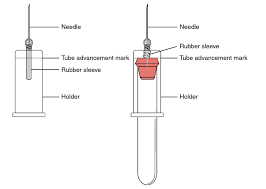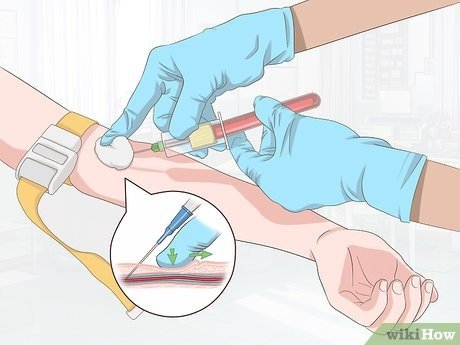Which of the following blood collection systems uses interchangeable multi-sample tubes that allow a phlebotomist to draw several blood specimens at the same time?
Evacuated tube system
Hypodermic needle and syringe system
Winged infusion set and syringe system
Lancet micro collection system
The Correct Answer is A
Choice A Reason:
The evacuated tube system is designed for the collection of multiple blood specimens using interchangeable tubes. This system utilizes a double-pointed needle, one end of which goes into the patient's vein and the other into a vacuum tube. As the blood is drawn, it automatically fills the tube until the vacuum is exhausted. The phlebotomist can then easily replace the filled tube with another without removing the needle from the patient's vein, allowing for multiple samples to be taken during a single venipuncture.
Choice B Reason:
The hypodermic needle and syringe system is typically used for manual blood draws when the evacuated tube system is not suitable, such as with small or fragile veins. This system does not use interchangeable tubes; instead, the blood is drawn into a syringe and then transferred into the appropriate tubes, which can be time-consuming and increase the risk of hemolysis or contamination.
Choice C Reason:
A winged infusion set, also known as a butterfly needle, is often used for patients with difficult veins. Like the hypodermic needle and syringe system, it does not inherently allow for the use of interchangeable multi-sample tubes. Blood is collected into a syringe or a single tube attached to the butterfly needle, and changing tubes usually requires a new puncture for each sample.
Choice D Reason:
The lancet microcollection system is used for capillary blood collection, typically from a fingerstick or heelstick. It is used for small volume samples and does not accommodate interchangeable multi-sample tubes. This method is commonly used for pediatric patients or when only a small amount of blood is needed.

Nursing Test Bank
Naxlex Comprehensive Predictor Exams
Related Questions
Correct Answer is B
Explanation
Choice A reason:
Cleaning the site is a step that should be completed before anchoring the vein. The site should be cleaned with an antiseptic to reduce the risk of infection. Once the vein is anchored, cleaning the site again could displace the vein and compromise the anchoring.
Choice B reason:
After anchoring the vein, the phlebotomist should perform the procedure, which involves inserting the needle into the vein at the appropriate angle. Once the needle is in place and blood is seen in the tubing, the phlebotomist can proceed to collect the necessary amount of blood into the vacutainers or syringe.
Choice C reason:
Examining the needle is not the next step after anchoring the vein. The needle should be examined before the procedure begins to ensure it is the correct size and gauge for the venipuncture and that there are no defects.
Choice D reason:
Reapplying the tourniquet is not necessary at this point in the procedure. The tourniquet should already be in place to engorge the vein, making it easier to anchor and access. Reapplying it could cause discomfort or even disrupt the already anchored vein.

Correct Answer is B
Explanation
Choice A Reason:
An angle of 50° is too steep for venipuncture and increases the risk of going through the vein and causing injury to structures beneath it. A steeper angle can also make it more difficult to control the depth of the needle, leading to an increased chance of puncturing the posterior wall of the vein.
Choice B Reason:
An angle of 30° is the recommended angle for venipuncture as it allows for a smooth entry into the vein without going too deep. This angle helps to ensure that the needle enters the vein in a controlled manner and minimizes the risk of injury to the patient. It also provides a good balance between ease of entry and control over the needle's depth.
Choice C Reason:
An angle of 90° is not recommended for venipuncture because it is perpendicular to the skin, which greatly increases the risk of passing through the vein entirely and causing injury. This angle does not allow for any control over the depth of the needle and is likely to cause discomfort or pain to the patient.
Choice D Reason:
An angle of 75° is also too steep for safe venipuncture. Similar to a 50° angle, it increases the risk of penetrating the posterior wall of the vein and potentially damaging surrounding tissues or arteries. It is important to use a lower angle to ensure the safety and comfort of the patient during the procedure.
Whether you are a student looking to ace your exams or a practicing nurse seeking to enhance your expertise , our nursing education contents will empower you with the confidence and competence to make a difference in the lives of patients and become a respected leader in the healthcare field.
Visit Naxlex, invest in your future and unlock endless possibilities with our unparalleled nursing education contents today
Report Wrong Answer on the Current Question
Do you disagree with the answer? If yes, what is your expected answer? Explain.
Kindly be descriptive with the issue you are facing.
